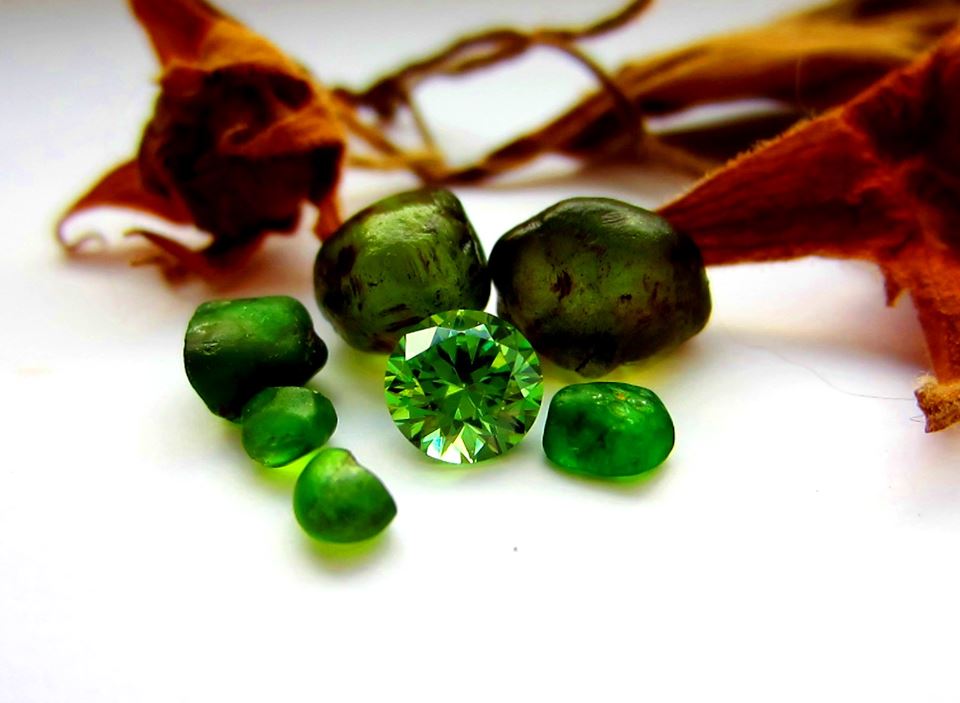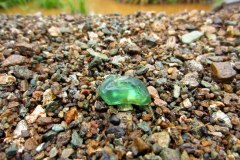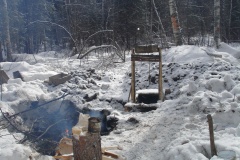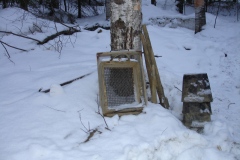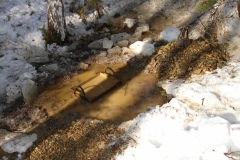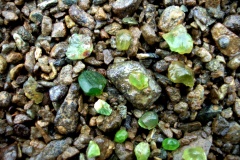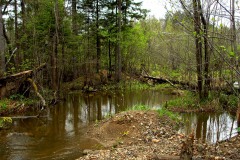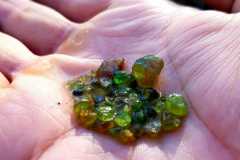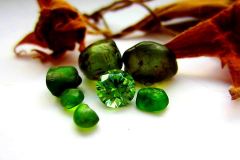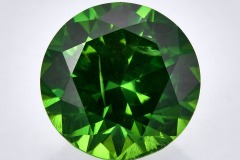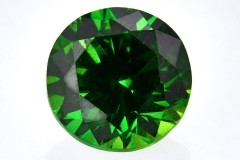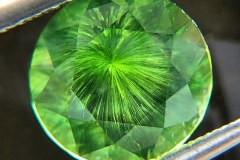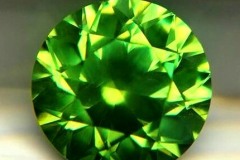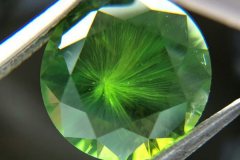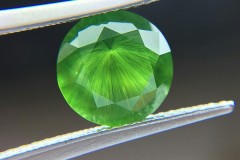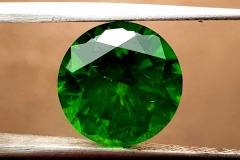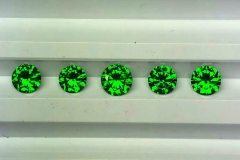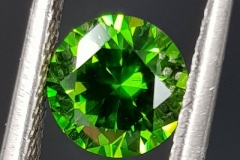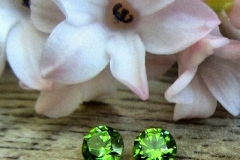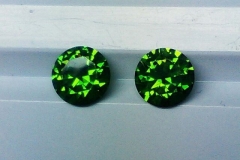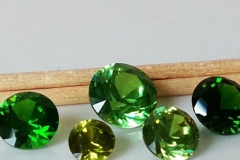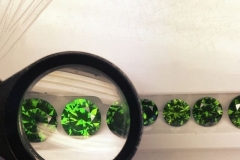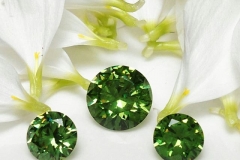Russian demantoid
Demantoid garnet is the rarest of all the garnet varieties and is valued by collectors for its exceptional brilliance and fire. The rarest and most valuable demantoid comes from Russia, and for serious gem investors only the Russian material is worth notice.
Demantoid belongs to the andradite variety of garnet, and is a calcium iron silicate by chemical composition. It has an unusually high refractive index, higher than ruby and sapphire, and this is one of the reasons for its impressive brilliance, but demantoid garnet also has remarkable dispersion or fire. It has the ability to split white light into the all the colors of the spectrum and has a higher dispersion rating than diamond.
The Russian stones display fine fibers of byssolite in a radiating pattern internally that has become known in the trade as horsetail inclusions. Demantoid from all localities (including Madagascar, Namibia, Italy, Iran, Brazil, etc) display this unique feature, but only Russian gems display long beautiful horsetails while horsetails from other localities display only short and in many cases distorted patterns that are not estheticaly pleasing. Therefore Russian Demantoid with beautiful eye visible horsetail inclusion command higher market prices compared to gems showing horsetail only under magnification or absolutely flawless gemstones. Beautiful eye visible horsetail inclusions are highly prized by collectors as well as jewelry makers because more and more knowledgeable buyers and investors are asking for demantoid showing esthetically pleasing horsetail inclusions.
This rare garnet was first discovered in the Ural Mountains in Russian in 1886 and was named demantoid for its diamond-like luster. It became a great favorite of European aristocracy in the late 19th century, but mining ended after the Bolshevik revolution in 1917. The mining in Russia has resumed in just the last 20 years.
Russian demantoid has been mined at 3 locations in the Ural Mountains, Klodovka, Karkodino, and Babrovka. The quality varies between the different locations. The Karkodino mine produces highly saturated greens but with a very dark tone. Most of the Karkodino material is heated to lighten the color. The material from the Klodovka and Babrovka mines is usually unheated and the Babrovka material is noted for its excellent fire.
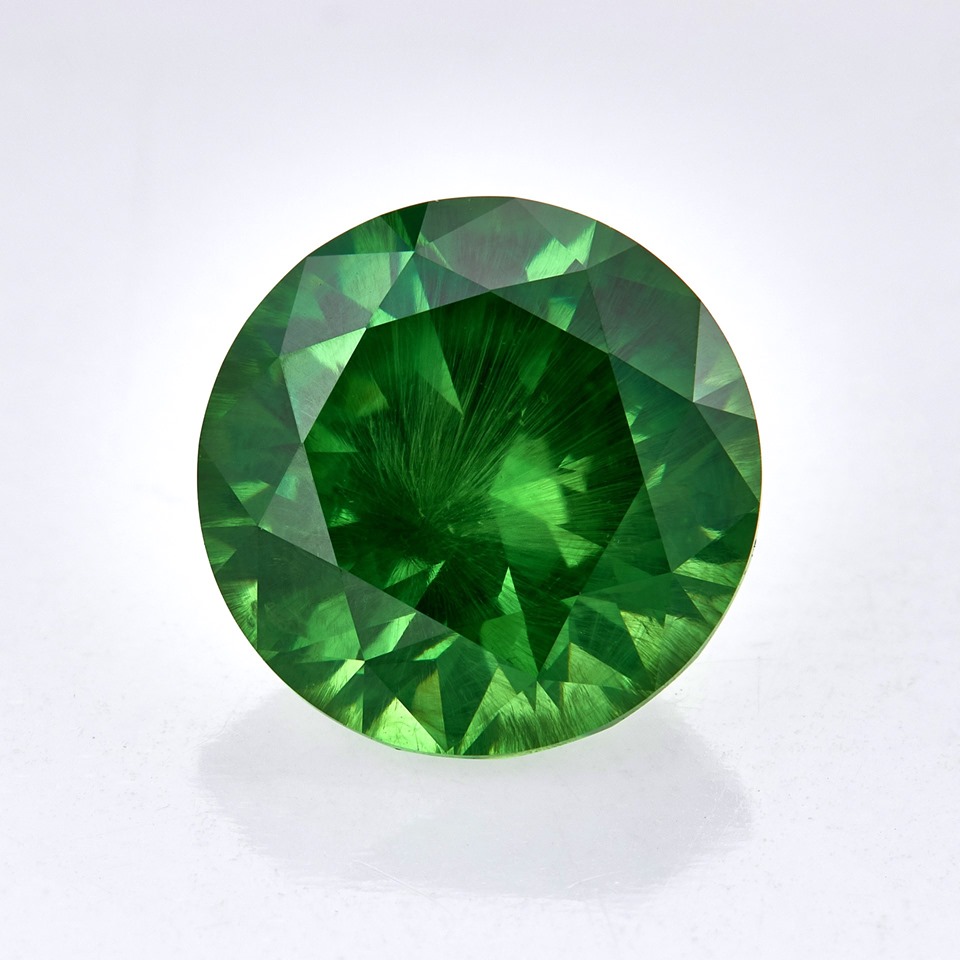 |
Though demantoid garnet has been found in other locations, notably Namibia and Madagascar, the quality of the top Russian material is far superior. The African demantoid tends be yellowish green, olive green or brownish, due to higher concentrations of iron. The Russian demantoid is colored by chromium and tends to be a pure vivid green.
Since the Russian demantoid is so rare and valuable, it has become known to every gem collector. The Russian stones display fine needles in a radiating pattern internally that has become known in the trade as horsetail inclusions. Only the Russian demantoid displays this unique feature, which is prized by collectors.
Russian demantoid garnet (Ca3Fe2[SiO4I3) is found mainly in small sizes, with most faceted stones being well under 1 carat. Gems over 1 carat are rare and gems over 2 carats are considered extremely rare. Any gem over 4 carats with good color and clarity belongs to the top-investment museum category. Only a handful of pieces in 8ct to 16ct are known to exist. Such world-class rarities are mainly in private hands of the rich and famous. The largest Demantoid in the USA is 11.24ct gem and is currently on display at the Smithsonian https://geogallery.si.edu/10002932/andradite-var-demantoid, With the hardness at 6.5 – 7.0 Mohs, these gemstones are suitable for luxury jewelry, usually set in gold or platinum. Demantoid is a gemstone of unsurpassed brilliance and fire due to its high refractive index of 1.89, coupled with a very high light dispersion (Demantoid: 0.057, Diamond: 0.044). Together with Paraiba Tourmaline and Russian Alexandrite, Demantoid belongs to the group of top 3 rarest popular gems It is considerably rarer than rubies, sapphires, emeralds and yes, even diamonds.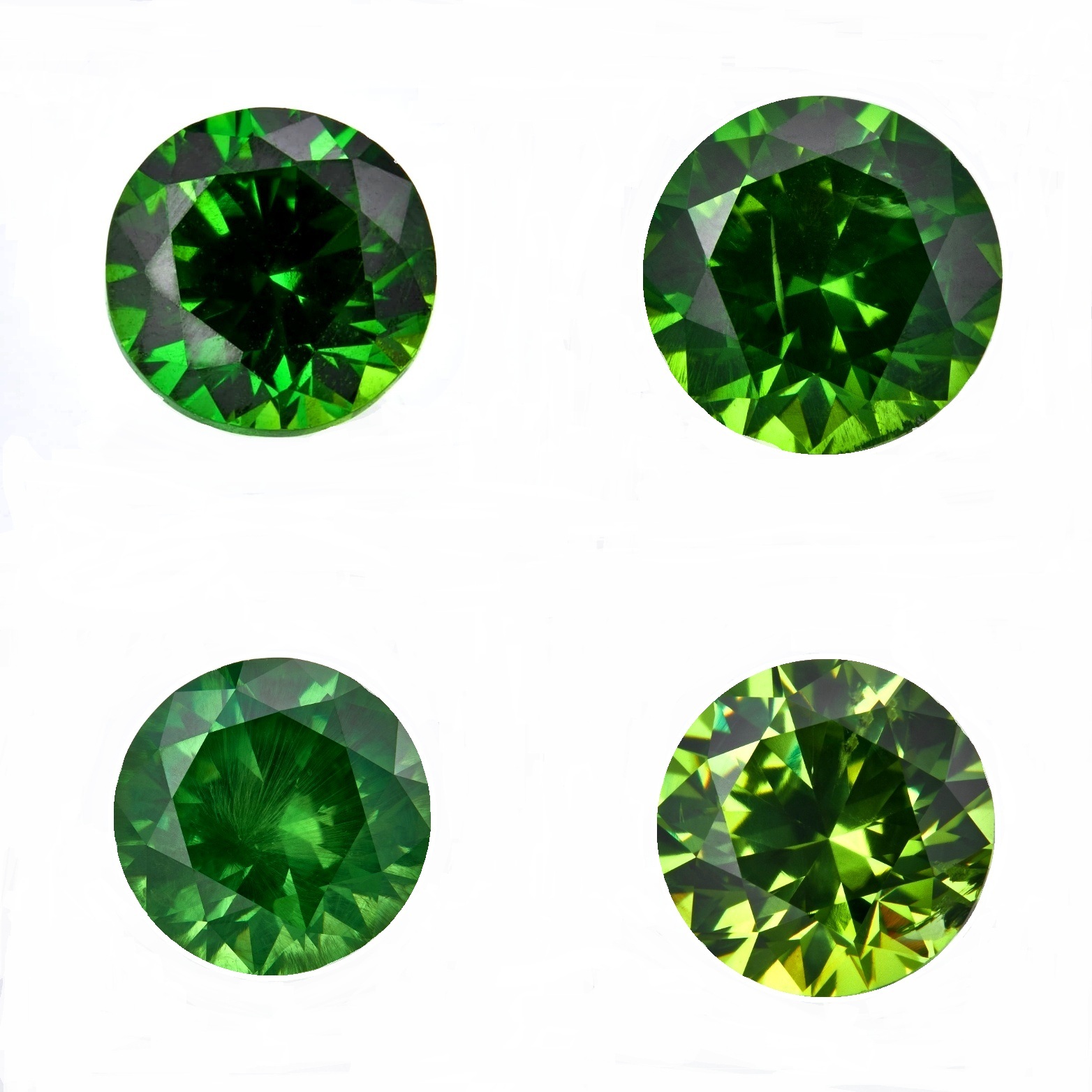 |
Demantoid (Ca3Fe2[SiO4I3) is the chromium-green gem variety of andradite, but it usually exhibits a yellow overtone due to intrinsic ferric iron. With a hardness slightly less than 7 demantoid is not a good ring stone. However it has a high refractive index [1.89] and dispersion [0.057. Diamond is 0.044.
Russian demantoid, Ural, Poldnevaya river, color range 2-3
History
About 1853 children from the settlement of Elizavetinslzoye whic is southwest of the larger village of Nizhniy Tagil (also known as Nazhniy Tagilsk) in the Central Urals, found unusual grass green pebbles during the heavy spring runoff of the Bobrovka River (Eichmann, 1870; Samsonov and Turingue, 1985). Local jewelers identified the green gem as chrysolite (olivine, [(Mg, FehSi041-generally known by gemologists as peridot). Mineral collecting was very stylish in late-19th-century Czarist Russia, especially among the nobility, and mineral collectors soon converged on Nizhniy Tagil in search of specimens of this gem.
This “Ural chrysolite” (which also was called “Bobrovsk emerald”, “Uralian emerald”, and “Siberian chrysolite”) soon appeared in the jewelry shops of Moscow and St. Petersburg mostly as small, fiery calibrated stones framing enamel work or the larger gems of the Urals, such as pink topaz or beryl.
Nils von Nordensheld a Finnish mineralogist who first gained fame in the Urals with his identification of the new mineral phenakite [Be2,Si04), arrived at Nizhniy Tagil a year after the initial demantoid discovery. He remained for a year and a half studying copper deposits in the area. P.V. Eremeyer (also spelled “Eremeev”), his friend and biographer, suggests that von Nordensheld never visited the actual site where the green stones were found, but rather examined specimens from several collections. On the basis of these examinations, von Nordensheld declared the green gem a new mineral and certainly not chrysolite.
On February 20, 1864, von Nordensheld described the beautiful green gem before the St. Petersburg Mineralogical Society as green andradite garnet colored by a small chromium content (Eremeyer, 1871). The fact that andradite has the highest R.I. and dispersion of any of the garnets explained the unusual brilliance and fire, and he proposed the name Demantoid which means “Diamond-like”.
Demantoid was very popular in Russia from about 1875 to 1920. It was even incorporated into some of the fabulous creations of Peter Carl Faberge and other court jewelers.
Serious efforts have been made to find demantoid deposits in similar geologic environments elsewhere in Russia. In 1980, one discovery was reported at a site in the Kamchatka Peninsula of eastern Siberia. The stones from this locality are usually small, but of good quality.
With the onset of the Bolshevilz Revolution in 1917 gems went out of vogue in Russia along with other symbols of wealth and royalty and Soviet resources turned to mineral production which was more in demand by industry. Deposits of emerald and other beryls were mined for their beryllium. Diamond was mined for industrial applications and the tailings piles of chrysoberyl mines were hand-picked for molybdenite. In the early stages of World War II Joseph Stalin moved the Soviet heavy industry to the Central Urals away from immediate Nazi invasion.
Location and Access
Two major districts in the Central Ural Mountains of Russia have historically yielded demantoid garnet: Nizhniy Tagil (along the Bobrovka River) and Sissertsk (near Polevskoy and Poldnevaya). These regions have alternating dense forest (spruce, pine, aspen and birch) and open meadows with much of the area being marshland.
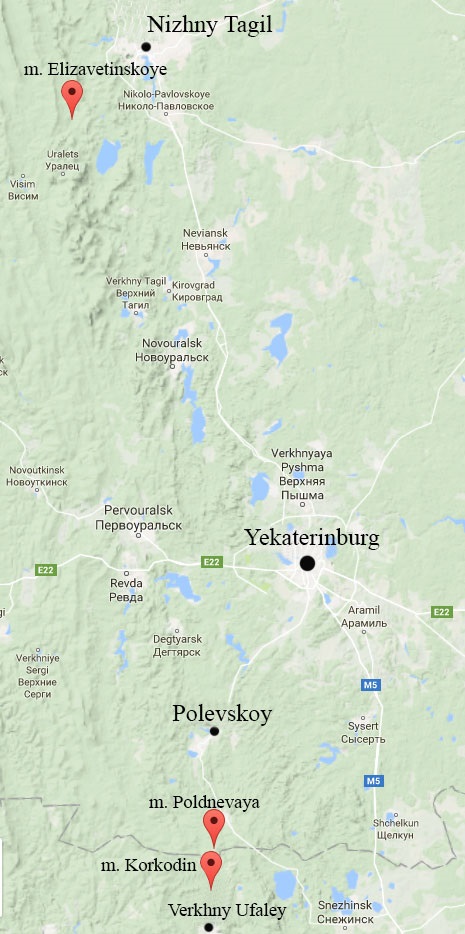
The Nizhniy Tagil district is near the tiny village of Elizavetinskoye about 115 km north-northwest of Ekaterinburg. It is best accessed from there via Nev’yansk and Nizhniy Tagil over paved roads. This district contains two deposits, the placer on the Bobrovka River (Bobrovskaya Placer) which runs for about 2 km through Elizavetinskoye, and a primary deposit at the head of the Bobrovka River (Tochilny Kluch), which is the source of the alluvial demantoid.
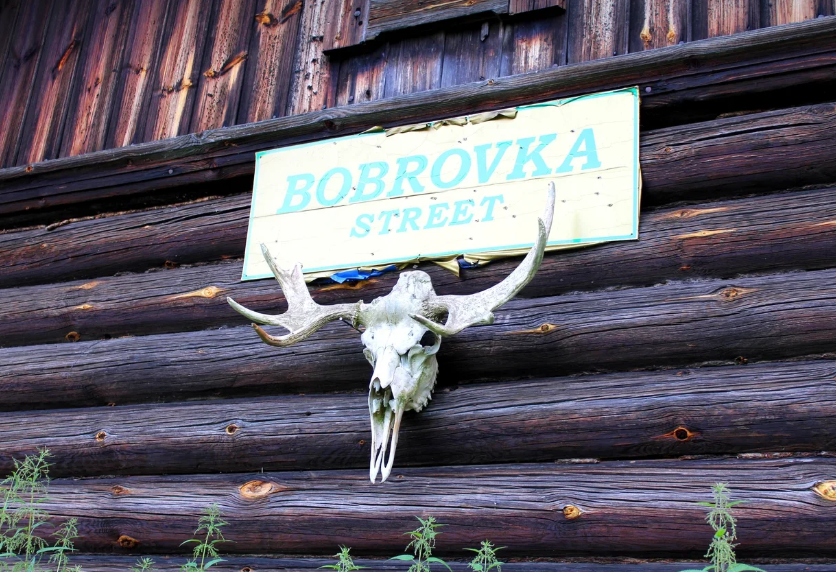
Village house near a stone deposit
The Sissertsk district lies between Poldnevaya and Verkhniy-Ufaley near the Korlzodin railway station which is about 75 km south-southwest of Elzaterinburg. All but four kilometers of the road from Elcaterinburg to the site (90 km is paved. In this district there are two primary in situ deposits at Kladovka and at Korlzodin. In addition there are five river placers, Bobrovka, Zyachiy Log, Ufaleylza, Chrisolitka and Kamenuschka
In 1985 a small demantoid deposit was discovered in the southern part of the Arctic Urals on the Hulga River. This new deposit contains both in situ demantoid and a small placer.
In 1995 another demantoid deposit was reported in the Arctic Urals on the Hadata River. The primary deposit is on the Saum-Kev pyroxenite massif and is accompanied by a placer deposit about 1 km long. It was scheduled for exploration and study in the summer of 1996.
There is one interesting distinctive feature of demantoids from the Poldnevaya and Tagilskoye fields. Color flashes of a stone in its dispersion differ in color. The stones from the Poldnevaya fields have a yellow flash. Stones from the Tagil Deposit have blue and purple flashes. This is due to traces of titanium.
Mining and production
Mining specifically for demantoid in Russia has been very erratic. Before 1915, the stones were usually obtained as a by-product of platinum mining of the placers at Elizavetinskoye and gold mining of the placers in the Sissertsk district. Since then, the demantoid deposits have been worked mostly by private miners, operating illegally who search river gravels or dig pits up to 5 m deep and then wash and screen the pit gravels. Only the contract companies have licenses to dig and even those may be for exploration only. Illegal digging is a dangerous profession as the authorities are always alert and local competition is keen. Miners have been subject to arrests, threats, and even shootings.
The nature where the demantoid is mined
In the 1970s, government geologists studied the Nizhniy Tagil-Elizavetinskoye deposits for commercial development, and for three to five years thereafter, the A0 Uralquartzsamotsvety attempted hydraulic mining. Recovery was poor (40%-60%), and much high-quality rough was lost in the tailings. However, most of the demantoid was ultimately recovered by the local people who work over every dump and tailings pile.
A very crude estimate would suggest that, prior to 1990 a total of perhaps 200 kg of demantoid rough had been mined. The total remaining commercial reserve of the Elizavetinskoye placers has been estimated at 2,000-3,000 kg. In 1993, the deposit was licensed to a metallurgical company (A0 NTMK [Nizhniy Tagil Metallurgical Kombinat]) for prospecting, but no commercial production has resulted. The license expires in 1997, and the company is desperately seeking foreign financing.
The Korkodin-Chrisolitlza deposit was explored in the late 1980s and a license was purchased by a private conglomerate (TOO “Grani”) from the Chelyabinsk region. A production company was formed and some small-scale organized mining began in 1994. However no commercial production has yet been reported. Reserves at the KorlzodinChrisolitlza deposit are estimated at 5,000 kg.
The Kamenuschka deposit about five km north of Korkodin, is unexploited, unlicensed, and remains available for development. Trenches cut by “bandit diggers” expose the bedrock and reveal demantoid in drusy cavities which are valued both for jewelry and as mineral specimens. No commercial production has been officially reported and the reserves at the Kamenuschka deposit are estimated at roughly 2,000-3,000 kg. Unofficial estimates place total demantoid rough production for 1995 at about 8 kg (Elizavetinskoye – 5 kg, Poldnevaya – 3 kg). About 40% of this total, some 16,000 carats, was cut for jewelry use. Less than 10% of the latter group, about 1,600 carats, was represented by stones of one carat or more.
Little more can be said at this time about the present status or future development of demantoid garnet in the Ural Mountains of Russia, except that interest is growing. Foreign investors are welcome and proposals to develop the deposits are under consideration. However, all of the areas containing demantoid, except Korkodin, supply drinking water to local cities so the serious development of any one of them could become an environmental concern.
In the next few years, the Russian government is likely to assume control of the production, cutting and distribution of demantoid as it has recently done with emerald and alexandrite. Demantoid may also be declared a gem of the “first group which would put it in the company of diamond, emerald, ruby, sapphire, and alexandrite and thus result in more stringent purchase and export regulations.
Political and economic stability in Russia is slowly brining further development of these world-class deposits. But even now, with newly introduced mechanization and commercialization of the demantoid mining industry these gems remain rare, extremely valued, highly sought after by world-class jewelers, wealthy collectors and those with a taste for unique and exotic gems.
Demantoid gallery
